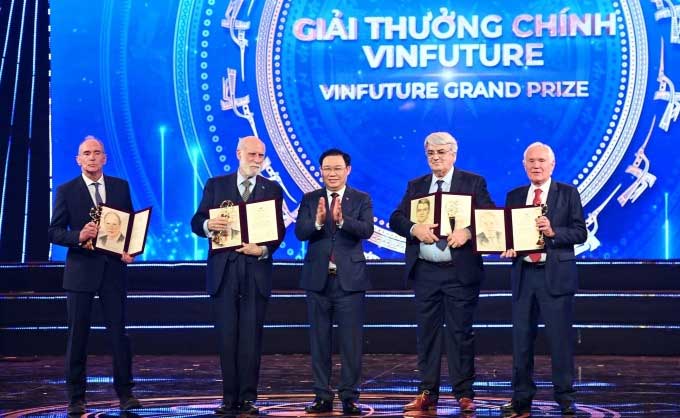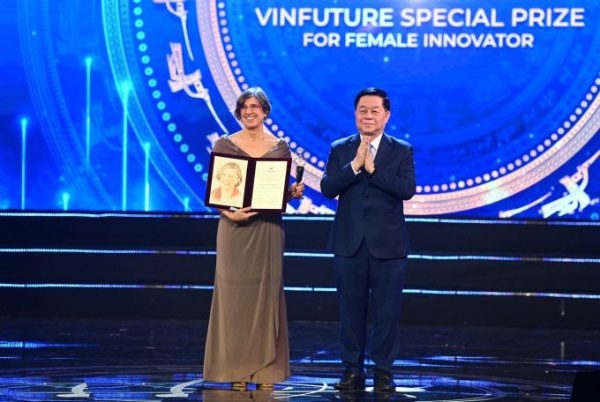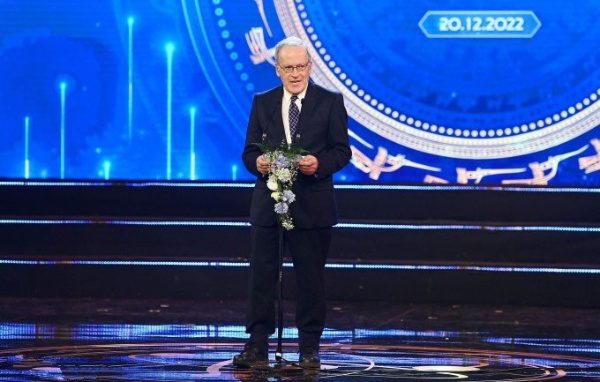Nine scientists were honored on the evening of December 20 in Hanoi for four pioneering studies that have created positive changes for millions of people around the world.
1. The Work “Turning the Internet into Reality”
The prestigious VinFuture Grand Prize, valued at $3 million, was awarded to five scientists who helped turn the Internet and the global network into a reality – a development that has permanently changed the way we live, communicate, and work, while laying the foundation for the progress of modern socio-economic systems.

Chairman of the National Assembly Vuong Dinh Hue (center) presents the award to 4 authors of the Grand Prize on the evening of December 20 in Hanoi. (Photo: Giang Huy).
The laureates include Timothy John Berners-Lee (the inventor of the World Wide Web); Robert Elliot Kahn and Vinton Gray Cerf (designers of the Internet); and David Neil Payne and Emmanuel Desurvire (developers of fiber optic Internet, the backbone of telecommunications and the Internet).
The research on the World Wide Web, the Internet, and fiber optic technology has become the dominant communication tool worldwide, enjoyed by billions of people for information retrieval, exchange, and easy connectivity.
Professor Timothy John Berners-Lee (67 years old), a British scientist, invented the World Wide Web. He wrote the first web browser and led the design and establishment of three essential Internet standards – HTML, HTTP, and URL. This web tool facilitates the seamless sharing and use of all information resources globally.
Two American scientists, Dr. Robert Elliot Kahn (84 years old) and Dr. Vinton Gray Cerf (79 years old), are known as the “fathers of the Internet” for leading the design and implementation of the Transmission Control Protocol and Internet Protocol (TCP/IP) – the foundation of the current Internet. These scientists established the fundamental design principles of the network, with TCP/IP being specified and prototyped to meet these requirements and oversee various protocol implementations that became the global standard for the Internet.
Today’s Internet relies on fiber optic communication. Their development was triggered by the research on Erbium-Doped Fiber Amplifier (EDFA) by David Neil Payne (78 years old, British) and Emmanuel Desurvire (67 years old, French).
Professor Payne is a world-renowned researcher in optics, with over 50 years in the field. He contributed to the fabrication of Erbium-Doped Fiber (EDFA) and demonstrated the first Erbium-Doped Fiber Amplifier. Meanwhile, Dr. Emmanuel Desurvire is known for his pioneering research on the physics of Erbium-Doped Fiber Amplifiers and multi-channel operations.
Fiber optic technology is one of the greatest scientific successes of the past three decades, and the contributions of Payne and Desurvire are recognized as exemplary across many fields. Their work enables the amplification of multi-color light signals in local area networks, intercontinental cables, and submarine cables, which are essential for fiber optic infrastructure that underpins the World Wide Web and the Internet. EDFA has revolutionized global networks by replacing outdated electronic repeaters with ultra-fast all-optical repeaters, eliminating the need for conversion from light to electricity. EDFA can amplify optical signals by up to 10,000 times at a capacity of 200 Tbit/s in a single fiber. Without EDFA, the Internet would have been limited to a cable capacity of about 40-100 Gbit/s between continents, potentially leading to skyrocketing costs and waiting times. Although this research was conducted over 35 years ago, no technology has emerged that can compete with EDFA.
2. Low-Cost Water Filtration System to Remove Arsenic from Groundwater
Professor Thalappil Pradeep from the Indian Institute of Technology Madras, Chennai, was awarded a special prize for scientists from developing countries, valued at $500,000, for his low-cost technology to remove arsenic from groundwater. Pradeep discovered suitable and advanced materials to eliminate specific contaminants in water in the most cost-effective and sustainable manner.

The special prize for scientists from developing countries was awarded to Professor Thalappil Pradeep, Indian Institute of Technology Madras, Chennai. (Photo: Giang Huy)
Rural people and the poor relying on well water in Punjab, northern India, have long faced the risk of water poisoning. To address this significant health and environmental hazard, Professor Pradeep discovered metallic nanoparticles that can break the bonds that connect and transport arsenic in groundwater. This bond-breaking technology effectively cleans groundwater at very low costs, benefiting millions of affected households.
In 2020, over 80 water purification systems using technology developed by Professor Pradeep were installed in Punjab, providing arsenic-free drinking water to approximately 150,000 people. The purifiers are also used in other states, including Uttar Pradesh, Bihar, and West Bengal, providing clean drinking water to over 7.5 million people.
3. High-Yield Flood-Resistant Rice Varieties for Over 6 Million Farmers
The special prize for a female scientist, valued at $500,000, was awarded to Professor Pamela C. Ronald from the University of California, Davis, USA, for her foundational research on flood-resistant rice varieties and the development of new high-yield rice strains.

Professor Pamela C. Ronald (left) receives the special award for female scientists. (Photo: Giang Huy)
Professor Ronald’s work pioneered the study of the rice gene (Sub1A) to develop superior flood-resistant high-yield rice varieties, particularly suitable for cultivation conditions in Laos, Bangladesh, India, and potentially applicable in rice cultivation in other countries. This is a groundbreaking discovery in rice cultivation and harvesting.
In 1996, David Mackill from the International Rice Research Institute (IRRI) discovered the flood-resistant gene in a low-yield Indian rice variety and sent it to Ronald. She successfully replicated the Sub1 gene region encoding three transcription factor regulators crucial for plant immune response to stress (harsh conditions) and ethylene-responsive factor (ERF).
She also demonstrated that one of these three factors, Sub1A (Submergence Tolerance Regulator), increases mutation in response to flooding and helps create genetically modified crops capable of prolonged flood resistance without affecting growth, yield, or rice quality.
Professor Ronald’s fundamental discoveries regarding the rice gene Sub1 related to the regulation of immune responses in rice under flooding conditions have led to the development of genetically modified rice varieties with superior flood resistance, bringing enormous benefits globally.
Currently, several Sub1A rice varieties have been developed and used in six countries: Indonesia, Nepal, Myanmar, India, Bangladesh, and the Philippines. In 2017 alone, over 6 million farmers in India, Bangladesh, and Nepal adopted the Sub1 rice variety for cultivation.
4. AlphaFold Project: An AI System Predicting 3D Protein Structures
Dr. Demis Hassabis from the UK and John Jumper (USA) received the special prize for pioneering scientists in a new field. The scientists from DeepMind developed AlphaFold 2, utilizing deep learning methods to predict protein structures. With AlphaFold, artificial intelligence (AI) has been shown to accurately predict the shapes of proteins with atomic-level precision, on a large scale and in minutes.

Professor Leslie Gabriel Valiant receives the award on behalf of and shares the speech of the two authors. (Photo: Giang Huy).
Determining protein structures provides fundamental insights into cellular processes, the development of new drugs, the proposal of new synthetic biology applications, and many other applications. Demis Hassabis conceived the idea of solving the protein structure prediction problem using deep learning and assembled the DeepMind team, where John Jumper was the lead scientist. The team produced and publicly provided a database of the structures of over 200 million proteins, empowering thousands of scientists to tackle issues affecting all communities, nations, and the world, allowing everyone to benefit.
The system for accurately predicting protein structures has potential benefits across many fields. In particular, it can enhance understanding of neglected tropical diseases (NTDs), whose unknown protein structures are a barrier to treatment. These diseases affect millions of people every year, causing tens of thousands of deaths. Due to limited information about human-related protein structures, the drug discovery process is slow and costly, taking about 10 years and $2.5 billion. Additionally, AlphaFold can help identify proteins and enzymes that can effectively break down industrial plastic waste or capture carbon from the atmosphere.
Now, biologists will be able to study how proteins interact and function. Furthermore, they can design new proteins, enabling faster drug discovery and decoding disease-causing gene variants.
The VinFuture Prize is awarded annually for groundbreaking scientific and technological inventions that have the potential to create significant changes in people’s lives. Launched on December 20, 2020, the foundation operates independently and as a non-profit organization, founded by billionaire Pham Nhat Vuong and his wife, with the goal of creating positive changes in the daily lives of millions of people around the world. The total prize value is 4.5 million USD, which includes one main prize of 3 million USD and three special prizes of 500,000 USD each, divided into three categories: Female Scientist, Scientist from Developing Countries, and Scientist researching Pioneering Fields. |


















































